Traducción generada automáticamente
Mostrar original
Mostrar traducción
Homage to Napoleon is a Watercolour Drawing realized by Mino Maccari (1924-1989) in 1965s. Hand signed on the lower margin. Good condition on a yellowed paper. Mino Maccari (Siena, 1924-Rome, June 16, 1989) was an Italian writer, painter, engraver and journalist, winner of the Feltrinelli Prize for Painting in 1963 and first winner of the Forte dei Marmi Satira Prize in 1973.After completing his secondary education, he enrolls in university. An interventionist like many young people of his time, he took part in the Great War at the age of nineteen as a field artillery officer. At the end of the conflict he resumed his university studies in Siena and in 1920 he graduated in law. In 1924 he was called by Angiolo Bencini to take care of the printing of the magazine Il Selvaggio, openly uncompromising fascist, revolutionary and anti-bourgeois, where his first engravings were published. After a few years of coexistence between work at the newspaper and the law firm, at the beginning of 1926 he left the legal profession to take over the direction of Il Selvaggio which he would hold until 1942. In 1928 he was the author of the small book published by Vallecchi (Florence), Il Trastullo di Strapaese (little songs and engraved woodwinds) which collected fascist songs (the same book was seized several times from Antonio Gramsci during his detention). with the transfer of the editorial staff of the Selvaggio in 1925 from Colle di Val d'Elsa to Florence, Maccari collaborated with Ardengo Soffici, Ottone Rosai and Achille Lega. In the meantime, between 1927 and 1930, he made himself known to the general public as a painter by participating in various national exhibitions. Also in 1930 Maccari works in Turin at La Stampa as editor-in-chief and has the writer Curzio Malaparte as director. His presence in the cultural and editorial world of the fascist regime is very intense, he writes and collaborates with various magazines: Quadrivio, L'Italia Letteraria, L'Italiano and Omnibus by Leo Longanesi; then, during the war, in il Primato di Bottai and, subsequently again, in Il Mondo di Pannunzio (from the first number, in 1949), up to Documento by Federigo Valli. His graphic production is also vast, ranging from the Album of Vallecchi (1925), Il trastullo di Strapaese (1928) to Linoleum (1931). Maccari illustrated in 1934 La vecchia del Bal Bullier by Antonio Baldini and in 1942 he published the Album folder, followed by Come quando fuori Piove and Il superfluo illustrata.For his pictorial work full of evident chromatic accentuations and fast brushstrokes, the violent drawing combined with the lively stroke of the graphic sign of his engravings, he is recognized by critics as a complete artist. In 1962 he was also entrusted with the presidency of the Accademia di San Luca in Rome and managed to obtain a personal exhibition at Gallery 63 in New York. His production of drawings, watercolors, temperas, etc. is endless, sometimes in collaboration with prestigious publishing houses; it is worth mentioning, just as an excellent example, the 32 b/w and color drawings with which he illustrated Il gusto di vivere, a volume that collects writings by Giancarlo Fusco, edited by Natalia Aspesi and published by Laterza in 1985. Maccari, Sienese and great contradaiolo della Torre, painted the Palio of 16 August 1970 won by Selva. In 1973 he was awarded the Political Satire Award of Forte dei Marmi, an award born in that year. He died without great fanfare, in silence, at the age of ninety, in Rome on June 16, 1989.
Homenaje a Napoleón es un dibujo a la acuarela realizado por Mino Maccari (1924-1989) en la década de 1965. Firmado a mano en el margen inferior. Buen estado sobre papel amarillento. Mino Maccari (Siena, 1924-Roma, 16 de junio de 1989) fue un escritor, pintor, grabador y periodista italiano, ganador del Premio Feltrinelli de Pintura en 1963 y primer ganador del Premio Satira Forte dei Marmi en 1973.Tras finalizar sus estudios secundarios, se matricula en la universidad. Intervencionista como muchos jóvenes de su época, participa en la Gran Guerra a los diecinueve años como oficial de artillería de campaña. Al término del conflicto reanuda sus estudios universitarios en Siena y en 1920 se licencia en Derecho. En 1924 fue llamado por Angiolo Bencini para encargarse de la impresión de la revista Il Selvaggio, abiertamente fascista, revolucionaria y antiburguesa, donde se publicaron sus primeros grabados. Tras unos años de coexistencia entre el trabajo en el periódico y el bufete, a principios de 1926 abandonó la abogacía para asumir la dirección de Il Selvaggio, que mantendría hasta 1942. En 1928 fue el autor del pequeño libro publicado por Vallecchi (Florencia), Il Trastullo di Strapaese (Pequeñas canciones y maderas grabadas), que recogía canciones fascistas (el mismo libro le fue incautado varias veces a Antonio Gramsci durante su detención). Con el traslado de la redacción de Il Selvaggio en 1925 de Colle di Val d'Elsa a Florencia, Maccari colaboró con Ardengo Soffici, Ottone Rosai y Achille Lega. Entretanto, entre 1927 y 1930, se da a conocer al gran público como pintor participando en diversas exposiciones nacionales. También en 1930 Maccari trabaja en Turín en La Stampa como redactor jefe y tiene como director al escritor Curzio Malaparte. Su presencia en el mundo cultural y editorial del régimen fascista es muy intensa, escribe y colabora con varias revistas: Quadrivio, L'Italia Letteraria, L'Italiano y Omnibus de Leo Longanesi; luego, durante la guerra, en il Primato di Bottai y, posteriormente de nuevo, en Il Mondo di Pannunzio (desde el primer número, en 1949), hasta Documento de Federigo Valli. Su producción gráfica también es vasta, desde el Álbum de Vallecchi (1925), Il trastullo di Strapaese (1928) hasta Linoleum (1931). Maccari ilustró en 1934 La vecchia del Bal Bullier de Antonio Baldini y en 1942 publicó la carpeta Album, a la que siguieron Come quando fuori Piove e Il superfluo illustrata.Por su obra pictórica llena de evidentes acentuaciones cromáticas y pinceladas rápidas, el dibujo violento combinado con el trazo vivo del signo gráfico de sus grabados, es reconocido por la crítica como un artista completo. En 1962 se le confía también la presidencia de la Accademia di San Luca de Roma y consigue una exposición personal en la Galería 63 de Nueva York. Su producción de dibujos, acuarelas, témperas, etc. es inagotable, a veces en colaboración con prestigiosas editoriales; cabe mencionar, sólo como excelente ejemplo, los 32 dibujos en b/n y color con los que ilustró Il gusto di vivere, volumen que recoge escritos de Giancarlo Fusco, editado por Natalia Aspesi y publicado por Laterza en 1985. Maccari, sienés y gran contradaiolo della Torre, pintó el Palio del 16 de agosto de 1970 ganado por Selva. En 1973 recibió el Premio de Sátira Política de Forte dei Marmi, galardón nacido ese año. Murió sin grandes alharacas, en silencio, a la edad de noventa años, en Roma, el 16 de junio de 1989.

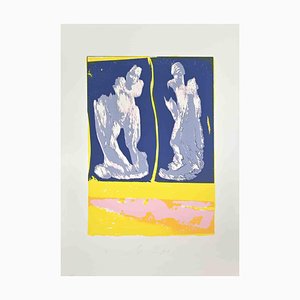
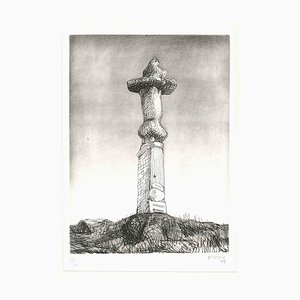
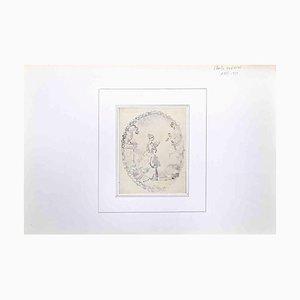


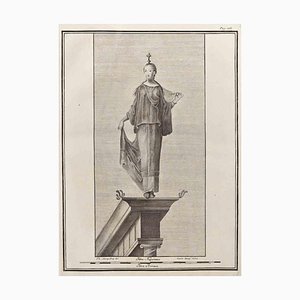
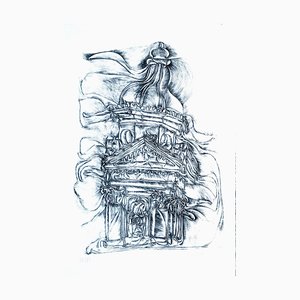

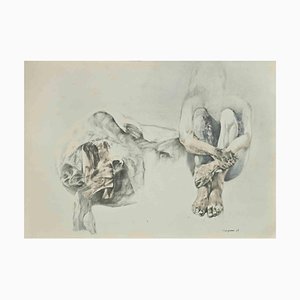

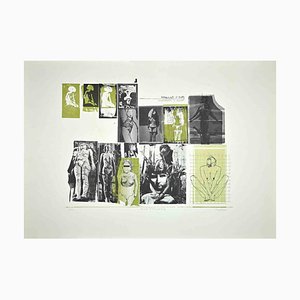

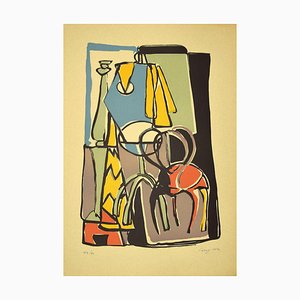
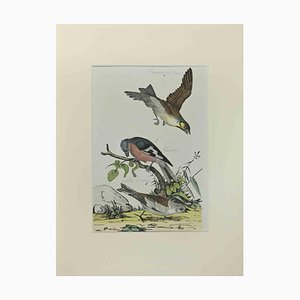



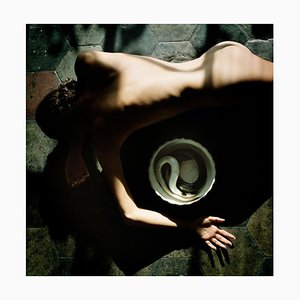

Contacta con nosotros
Haz una oferta
¡Hemos notado que eres nuevo en Pamono!
Por favor, acepta los Términos y condiciones y nuestra Política de privacidad
Contacta con nosotros
Haz una oferta
¡Ya casi está!
Para seguir la conversación en la plataforma, por favor completa el registro. Para proceder con tu oferta en la plataforma, por favor completa el registro.Exitoso
Gracias por tu consulta, alguien de nuestro equipo se pondrá en contacto contigo en breve.
Si eres profesional del diseño, por favor solicita aquí los beneficios del Programa comercial de Pamono